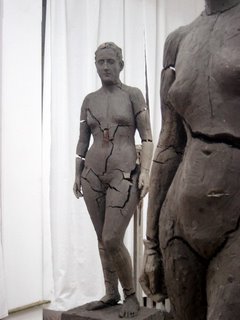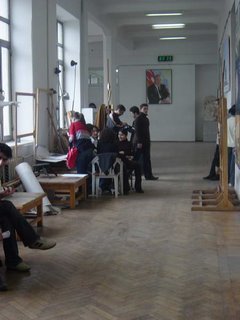
راستش اين مقاله ارتباطی به مجسمه سازی نداره ولی برای من که خيلی جالب بود.
من اين مقاله رو از کتابی که با emule دانلود کرده بودم برداشتم به همين خاطر نميتونم به
منبع لينک بدم ولی اصل مقاله رو هم به زبان اصلی آوردم.
با استفاده از روش NLP شما ميتوانيد با نگاه کردن با چشم های هر کسی فکر او را بخوانيد!
البته نه راجع به اين که چه فکری ميکنند ، بلکه راجع به اينکه چگونه فکر ميکنند. با اين روش شما
ميتوانيد راجع به چگونگی فکر کردن طرف مقابل پی ببريد.
اين روش به وسيله Bandler و Grinder پايه گذاری شده است.
...
وقتی که شما فکر ميکنيد حرکت چشم های شما به صورت غير ارادی منعکس کننده
افکار درونی شما هستند. مثلاً وقتی مخاطب شما به طرف پايين سمت چپ شما نگاه کرد
اين به اين معنی است که او با خودش صحبت ميکند.اين روش در مورد افراد راست دست و بسياری
از افراد چپ دست و بعضی از افرادی که با هر دو دست مينويسند صدق ميکند.
Vr
حافظه تصويری (virtual rememberd)
به ياد آوردن تصاوير ، به خاطر آوردن چيز هايی که قبلاً ديده ايد.
مثال: "ديوار های اطاق شما چه رنگی است؟" ، "درب وردی خانه شما چگونه است؟"
Vc
خلاقيت تصويری (virtual constucted)
فکر کردن به چيز هايی که تا بحال نديده ايد و برای به وجود آوردن آن از تخيل خود بهره ميگيريد.
مثال:"اگر ديوار های اطاق شما ابی بود چگونه بنظر می آمد؟"، "اگر سگ شما
سری به شکل فيل داشت چه شکلی ميشد؟"
علاوه بر اين بعضی از افراد اين کار را با بر هم زدن کانون ديدشان هم انجام ميدهند،در اين صورت
معمولاً چشم ها به روبرو خيره ميشوند.
Ar
حافظه شنودی(auditory rememberd)
به ياد آوردن اصوات ، به خاطر آوردن چيز هايی که قبلاً شنيده ايد.
مثال:"آيا صدای پدرتان را به خاطر داريد؟"
Ac
خلاقيت صوتی(auditory constracted)
تصور کردن چيز هايی که تا بحال نشنيده ايد و برای به وجود آوردن آن از تخيل خود بهره ميگيريد.
مثال:"اگر جرج بوش صدای اردک در بياورد چه صدايی پيدا ميکند؟"،"احمدی نژاد چطور؟؟؟"
K
احساسات (kinesthetic)
وقتی که به احساساتتان فکر ميکنيد معمولاً به اين جهت خيره ميشويد.
مثال :"وقتی به فرش دست ميزنيد چه حسی پيدا ميکنيد؟"
Ad
مکالمه درونی(auditory digital)
وقتی که با خودتان حرف ميزنيد چشمان شما به اين جهت خيره ميشوند.
...In the process of creating NLP, Bandler and Grinder discovered
that by looking at someone's eyes, you could tell HOW they think. Not what they think,
but HOW they think. You can tell what they're doing inside.
Based on observations by Bandler and Grinder, when people look up, they're visualizing.
When they look horizontally to the left and right, they're either remembering or
constructing sounds. When they look downward and to our left, they're accessing their
feelings. And when they look downward and to our right, they're talking to themselves
(Auditory Digital). The chard above is for a "normal" right handed person. Many
left-handed people and some ambidextrous people will have eye movements that are
reversed.
Vr
Visual Remembered
(Visual Recall) - Seeing images from the memory, recalling things
you're have seen before.
QUESTION: "What color was the room you grew up in?" "What
color is your bedroom now?" "What does your coat look like?"
Vc
Visual Constructed
(Visual Created) - Images of things that you have never seen
before. When you are making it up in their head, you are using
Visual Constructed.
QUESTION: "What would your room at home look like if it were
blue?" "What would your dog look like if it had the head of an
elephant?"
(In addition, some people access visually by defocusing their
eyes. When this happens, the eyes will usually stay in the center.)
Ar
Auditory Remembered
(Auditory Recall) - Is when you remember sounds or voices that
you've heard before or things that you've said to yourself before.
When you ask someone, "What was the very last thing I said,
they typically look in that direction.
QUESTION: "Can you remember the sound of your mother's
voice?"
Ac
Auditory Constructed
(Auditory Created) - Is making up sounds that you've not heard
before. For example
QUESTION: "What would I sound like if I had Donald Duck's
voice?" "What would Swan Lake sound like if it were played on
bagpipes?"
K
Kinesthetic
(Feelings, Sense of Touch) - You generally look in this direction
when you're accessing your feelings.
QUESTION: "What does it feel like to touch that rug?"
Ad
Auditory Digital
(Talking to Yourself) - This is where your eyes move when you're
having internal dialogue.
QUESTION: "Can you recite the Pledge of Allegiance?"
Typically, every time we access our brain, we move our eyes in that particular direction
which facilitates our using that part of our neurology. The mind and body are absolutely
interconnected, so each time we access our Visual Memory, for example, we move our
eyes upward and to our left. (If you're watching someone access Visual Memory, you
will see them move their eyes upward and to your right.)
Copyright ©2000 Mojo Publishing. All rights reserved
















